 By Brenda Cannon Henley
By Brenda Cannon Henley
(Editor’s Note – I do not aspire to be a prophet of doom and gloom, but I do believe it is important to remember the facts as they happened and the heroes that made the recovery seen now possible. I write this from a first hand experience because the Bolivar Peninsula and the beautiful Southeast Texas Coast is my home and my heart is deeply vested in it).
Background information:
When Hurricane Ike hit the Bolivar Peninsula in the early morning hours of Saturday, September 13, 2008, all five communities were affected. At 2:10 AM, many lives were changed for eternity. In fact, the communities were almost wiped from the map. We do not have towns or cities on the Peninsula and our home is not an island, as many have indicated. Instead, we have long-standing communities with rich and vivid histories. The residents resent it when only one is named or Galveston supersedes all other news and information. From High Island to Gilchrist, on to Caplen, then Crystal Beach, and finally, Port Bolivar. If you have done your homework, or have had the privilege of talking with those who trace their history back many years, you will know that Caplen once was an active hub of fun and excitement for both residents and visitors. The train stopped there for the beautiful old hotel that drew visitors from far and wide.
Texans jumped in and helped when Katrina hit New Orleans. We gave all of the extra supplies on hand, including cots, food, medicine, and other necessities of life. We had Gustav just before Ike, and no one could have predicted the onslaught that would soon hit the people of the Texas coast. Many felt that the officials in charge had handled Katrina badly and our officials including the mayor of Galveston, county commissioners, county judge, and the governor did not intend to make the same mistakes that the news media had covered well. The mayor of Galveston, now deceased, instructed her people to write their name and social security number on their arms with a magic marker so that when their bodies were found, they could be identified easily. The governor instituted one of the tightest blackouts on Bolivar after Ike that many have ever seen. I personally got into New Orleans easier after Katrina than I did on Bolivar.
After the physical storm:
We were heading into a major election and the economy took a downward turn. News was abundant on the national scene, but not about the hard-hit Bolivar Peninsula, the little spit of land on the coast, as it was called by one commentator. All media could get into Galveston and other places easier and they did not want to try to get to Bolivar. Remember that the ferries were down due to the landings being damaged so badly. Rollover Pass Bridge had a huge hole in the center and getting to the Peninsula required driving many miles and then passing through tight inspection stations coming out of Winnie and again at High Island. Access was made by boat on the Intracoastal and many looters took advantage of that avenue clearing properties filling big black bags with the lives of our people that were scattered in the wake of the storm. Organized relief was slow in coming because of the many obstacles and the black out continued.
Residents were not allowed back on the Peninsula for several weeks in an official capacity, but some made it back anyway without permission. They were dismayed at what they found.
My employer arranged for a charter plane to be waiting at the airport on Thursday following Ike, and we filed a flight plan for doing a story on debris in the Gulf and there was plenty. Entire homes were floating and bouncing in the serene looking water. He also knew how much we wanted to know if we had a home still standing. The pilot was wonderful and he flew back and forth several trips for the length of the Peninsula. We took photographs even though we could not identify streets and landmarks because nothing was the same. Sand was blown…and street signs and business markers non existent.
On Saturday, by the grace of God and one very kind DPS officer that read The Examiner out of Beaumont, I was allowed back on the Peninsula and after being escorted across Rollover, Ted, my now deceased husband, and I toured the neighborhoods. I had a list in my pocket of 17 friends that also wanted to know if they had a home. We went as best we could to each of the homes and I wrote a short dialogue of what we saw.
Statistics of importance:
Statistics tell a story and this one was a horror beyond description. Unless you were there and had your boots on the ground, I really don’t expect you to get it in its fullest force. The first thing I noticed was the awful smells. Think with me. Homes were blown open or apart. Restaurants and bars and barns and schools had everything inside of them at the time the storm hit now on the outside sitting in the hot Texas sun. Rotten is one word, but decay is another that comes to mind. We had no power, no water, no transportation in and out, no gas, no food, and no medical equipment to speak of at the time. If you had money in the bank, you could not get it out, and even if you could, where were you going to spend it? I was so hot and dry one afternoon clearing our property, I asked Ted to please get me a soft drink in ice. He smiled sweetly, and said, “Where exactly would you like me to get it?” That was the same day I found a long, white, human bone in our yard. I turned it over to the sheriff’s department for investigation.
Livestock was dead and bloated in the heat. Cows and horses burst open and stank badly. Other wildlife was displaced and practically gone. People’s pets, dogs and cats, were dead and remained where they had fallen. Rotting food was unbelievable. The destruction looked exactly like a war zone. Expensive cars, trucks, and equipment were in piles partially covered in sand. Houses and garages, tool sheds, and lawn furniture were crumpled and misshapen if there at all. Commodes were scattered in almost every yard and along our roadways. As Ted and I walked over Bolivar that Sunday afternoon, it was a contrast in sights. The Gulf was as pretty as I have ever seen it. It was blue and glimmering, but when your eyes returned to land, the horror greeted you anew. Worst of all, our people were missing. We did not know for months if many were alive or dead, if they made it out, or were swept out to sea, or were now laying in a hot pasture or in drainage ditch covered in sand. Literally, months went by without these issues being resolved for many.
Statistics can be confusing, and according to what you are searching for, hard to determine. Overall, national news banks say that over 140,000 residents in the Texas Gulf Coast danger zones in Ike’s path had failed to evacuate for many reasons. At least, 940 were rescued from rising waters and nearly 2,000 rescued afterward. At the end of December 2008, 37 people were known to have lost their lives in Texas. Of this number, four lived on my short street. The storm was said to be a Category 2 with 110 mph winds on impact, but many question that statement. The storm surge that followed in the storm’s wake caused much of the damage. It is quoted that 2.8 million to 4.5 million homes and businesses lost electricity for months.
The statistics for Bolivar Peninsula alone are:
- 3,600 homes destroyed or damaged so badly they could not be inhabited
- 4,200 vehicles destroyed
- Every business was destroyed or badly damaged
- 29 people lost their lives on Bolivar (some disagree with this figure)
*Ike is now ranked as the 7th costliest storm coming in at $34.8 billion (It was at one time ranked as No. 3 before latest large storms)
Heroes to the rescue:
Our first responders, law enforcement officers, most of the DPS crews, and our locals were the first heroes after Ike. They worked tirelessly to help wherever and however they could. The Governor’s Task Force got bad reviews for some of the things they pulled particularly at Fort Travis where many late rescues took place. When the area was opened up and the black out lifted, the carpetbaggers and the storm chasers came in droves. The “help” they offered caused more damage than good in many cases and many of our people were hurt badly in financial and emotional ways. Some saw a good thing and stayed to make even more money off the struggling residents. Debris removal was a huge business and great mountains of it lined our roadways. The odor remained for months.
Churches and faith based groups, as well as volunteer groups from many states, came and helped clear and rebuild. We had a terrible battle with insurance and it took years before some claims were paid. A group of Bolivar residents went to Austin on March 13, exactly six months after Ike hit, to protest unfair treatment at the hands of TWIA. That is another story for another time. The first big semi truck I saw in Bolivar was one from the Mormon Church of Latter Day Saints, and it came filled with water, ice, food, and cleaning supplies. What a treat to have ice for cold drinks and food other than MRIs.
The people of Bolivar are resilient — Much more so than some predicted or imagined. Many made it, while some could not. Only God truly knows what Ike did on Bolivar and throughout Texas and only eternity will reveal the good guys from the bad guys.
Our story is told in much more detail in my book, Winds over Bolivar, on Amazon.com. I was asked in a national interview after Ike if any good came out of the storm. I said immediately, “Yes, good did come out of Ike. I made so many new friends in our rebuilding and fighting insurance and they are now my Sisters of the Salt and Brothers of the Brine. We hung tough together, did not let anything separate us, and fought tooth and nail to get our lives back on track.” You can read these ladies’ stories in Winds: Catherine Jackson Prieur, Pam Adams, Terri Seiley Ward, Cindy Clay Srader, Deborah Reed, Joni Harding, Martha Henley Ladd, Debbie Valentine, Melissa Bech, Francie Boggan, and Erin Mulvaney. Bill Roske also shares his recollections of his mother, Glennis Mae Dunn, whose body was never found.
Photos by Ted J. and Brenda Cannon Henley
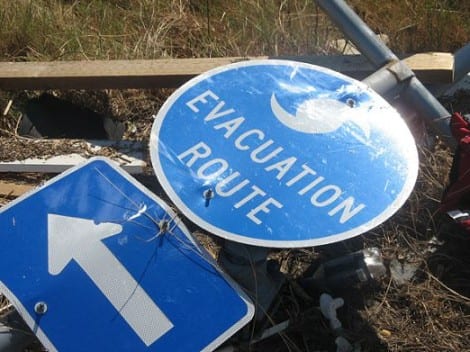
Even the evacuation signs were destroyed by the mighty wind from Ike
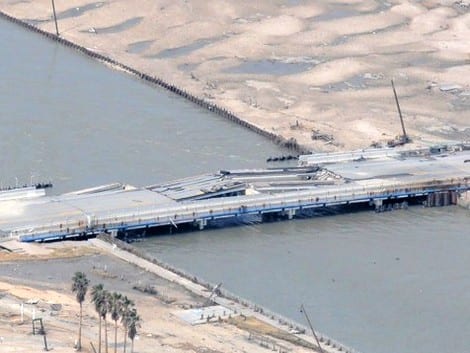
Rollover Pass Bridge with so much gone and big hole in pavement over the water
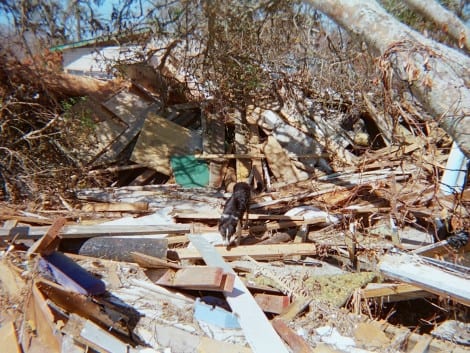
Cadaver dog searching for bodies in piles of rubble along the roadway
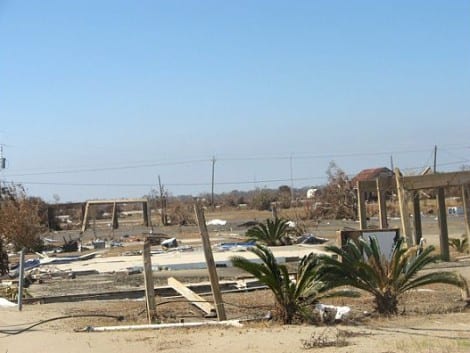
What was left of our home at 1220 Front Street, Port Bolivar
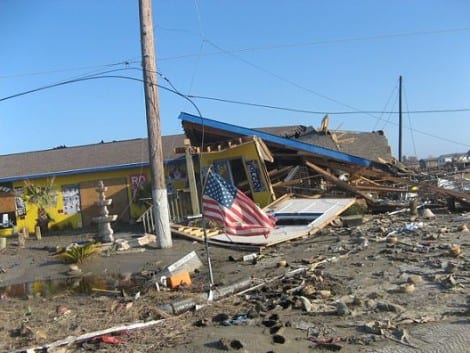
One of the 3,600 residences destroyed during Ike
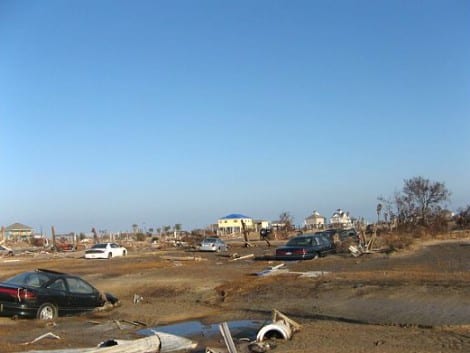
A few of the 4,200 vehicles scattered over the Peninsula. Most families owned more than one car or truck, but elected to travel out all together in one vehicle
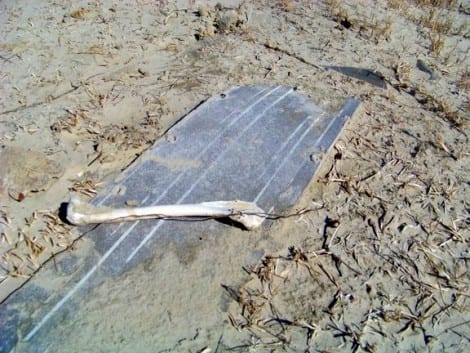
The white, long bone I found in my yard the first time we tried to move debris
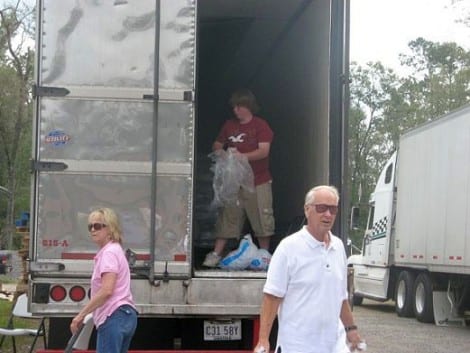
The first real sign of hope and help — A huge semi truck from the Church of Latter Day Saints bringing ice, water, food, and cleaning supplies
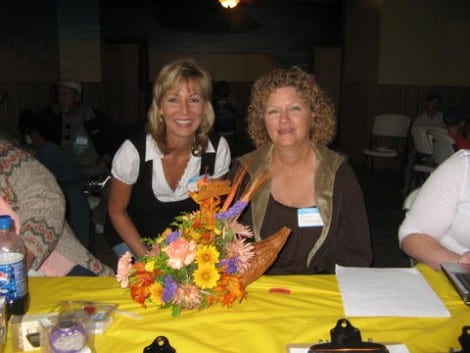
Yvonne Van Zant and Pam Shelander at the welcome table for the first Thanksgiving after Ike. So many had no where to go that we planned a big meal with games and door prizes for the residents that were on Bolivar and those that could get home for the holiday
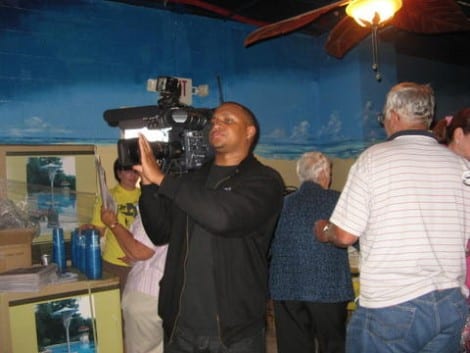
News coverage of our Thanksgiving event at Coconuts
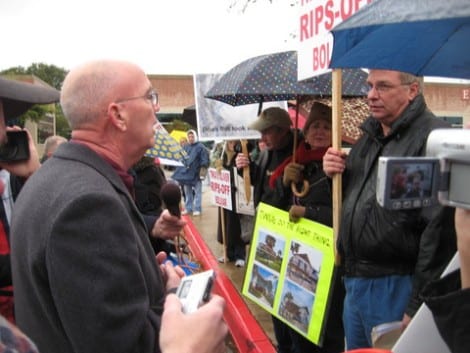
James Oliver, executive director of Texas Windstorm Insurance Association and Michael Likos during our demonstration in Austin on March 13, 2009, exactly six months after Ike hit
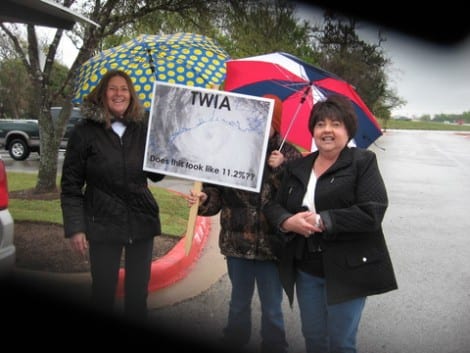
Joni Harding, Dana Turner, and Brenda Cannon Henley at TWIA fighting for our rightful money
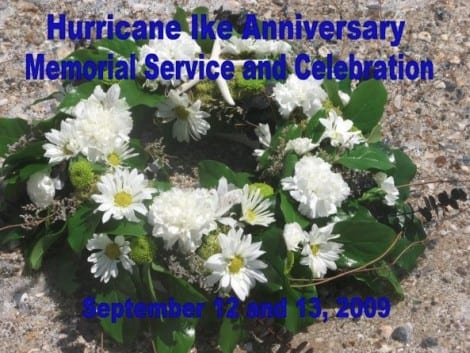
The beautiful wreath made by Yvonne Van Zant and sent out to sea on the one year anniversary of Ike honoring all that we lost
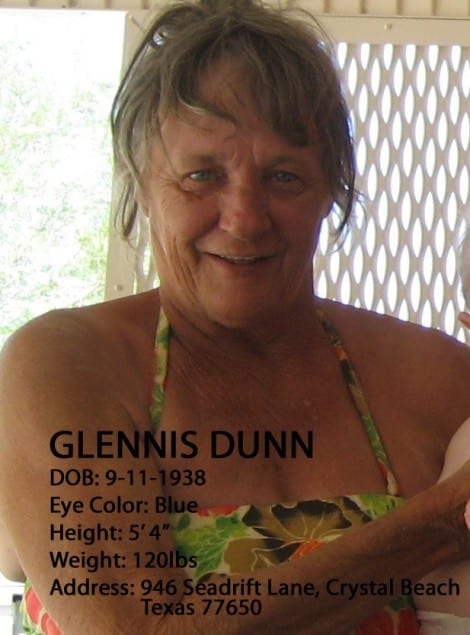
14. Glennis Dunn, whose body has never been found, even though her hastily packed car was located covered in sand several months after Ike
Brenda Cannon Henley can be reached at (409) 781-8788, or
[email protected]
[9-10-2018]

 Posted in
Posted in 
























It was so terrible getting back to Bluewater Subdivision where my trailer was parked. Luckily my friend and I took our trailers home but all my neighbors homes were no longer there. I to remember the debris and cars everywhere. I remember getting ice and military meals as that was all there was at the time. We finally brought our trailers back and my neighbors rebuilt there homes. Crystal Beach is again a thriving home for some and tourist attraction . But we can never forget what happened that day as it like 9/11 will be etched in my mind forever .
We lived on sea drift right past Glynnis. Every day she and her little fat black dog Jacque would walk past us going to the beach. Once in the morning. Again in the afternoon. I talked to her every day and loved her stories. I asked her about leaving for Ike and got the same answer as always. She had ridden out all the storms before and would do it again. When we found out what happened I was crushed. Still bothered by this to this day. We lived there full time and lost everything. Our life has not been the same. We tried moving back but to different land. I couldn’t go back to original house site. Unfortunately it didn’t work out for us It’s not the same but I guess we are not the same either. Very painful for us both. I miss Glynnis and our daily chats. Only God knows what happened that night. We never found anything from our house. No boat no pool table no deck no steps 😪. I just can’t get over it. We were next to the sleu and fed turtles and ducks. Never saw them again either. It’s just so painful to talk about but having someone who also went thru it helps. I’ve tried talking to others and they just can’t grasp the situation. They didn’t loose their whole life overnight. 40 years married and all of it gone. I’m sorry for your loss too Thanks for your wonderful stories
Thx for sharing your memories of my mom. Coming up on 11 years now and I am still googling her name…still missing her.
what a great story. It brought tears to my eyes. My family has been coming to Crystal Beach for 30+ years to vacation. Still love it.